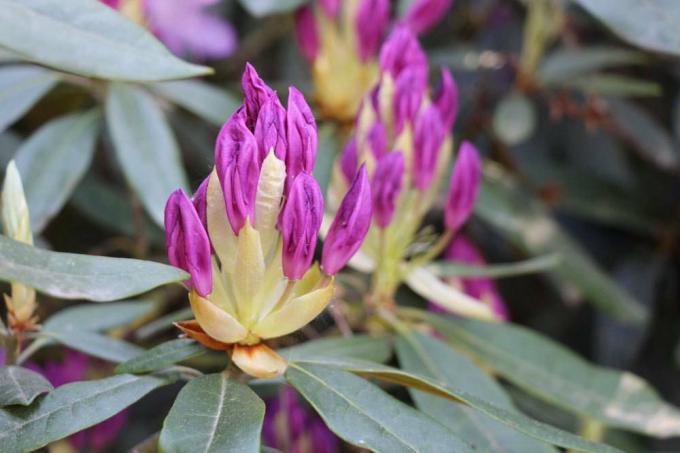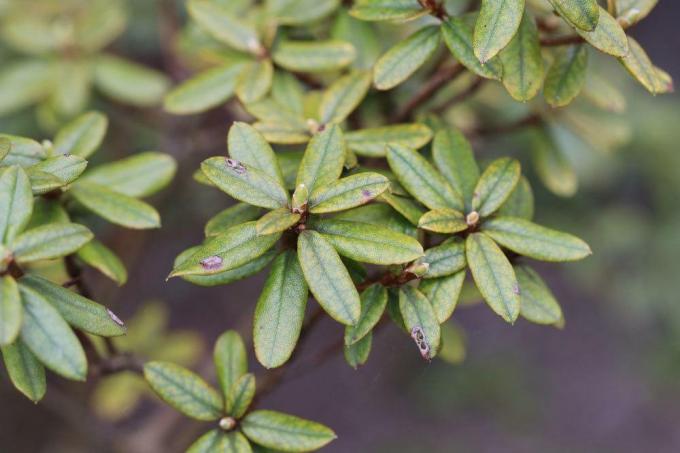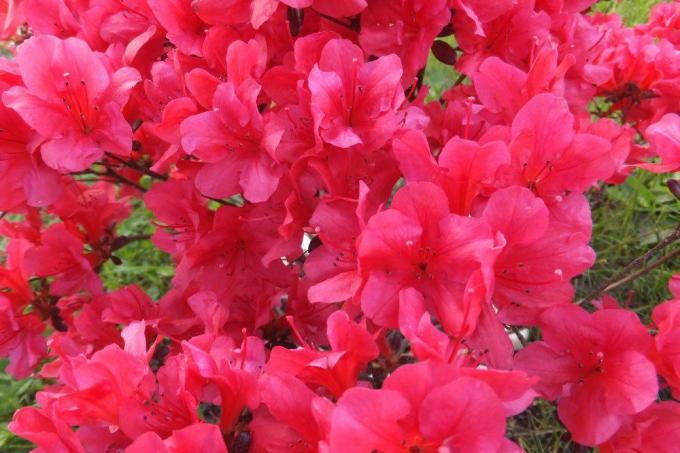
table of contents
- Rhododendron cicada
- Buds
- Pesticides
- Negative influences
- care
- Deficiency symptoms
- Iron deficiency
- Nitrogen deficiency
- Lack of buds
If the rhododendron does not bloom despite the buds and leaves, this can have various causes. This article describes the most important and gives practical tips. In some gardens there are (apparently) healthy, lush rhododendrons. They grow and flourish, but they don't bloom. Often it is very difficult to find the cause. The explanations in the guide can help with diagnosis and treatment.
Rhododendron cicada
The most common reason why rhododendrons do not bloom despite buds and leaves is an infestation by the so-called rhododendron cicada (Graphocephala fennahi). Here is an overview of the characteristics of the insect, feared by many hobby gardeners.
- 8 to 9.5 mm long
- strikingly green in color
- red striped wings
To proceed or Course:
In late summer or autumn, the rhododendron cicada lays its eggs under the scales of the new flower buds of the rhododendron plant. As a result, small wounds appear on the buds. These serve as a gateway for a harmful fungus that is transmitted and spread by the insect. After infection with the harmful fungus, spoilage takes its course.
Note: In the case of weakened rhododendrons - such as those that are planted in an unfavorable location - an infection with the fungus can occur even without the involvement of the cicada.
Buds
During the winter, the buds of the plants turn brown and die by spring. In addition, black, prickly fungal fruit bodies develop on the infected buds. Although these bodies are very small, they are immediately noticeable due to their dark color.
Once the damage has been done, the only thing left to do is to generously remove the infected buds. However, it usually takes at least two years before the rhododendrons can bloom again. For this reason, it is advisable to initiate suitable control measures a few weeks before the potential infestation. Experts advise preparing the plants accordingly in summer. From around September the adult females of the rhododendron cicada are ready to fulfill their egg-laying mission. Once the fall occurs, the bloom for the next year is lost. Therefore you should bait the animals in advance.
Tip: Glued yellow boards from specialist gardeners are ideal for attracting and catching insects. One trap is sufficient for each rhododendron plant.

Pesticides
Treatments with approved pesticides can also be considered. It makes sense to be active in the early morning hours. At this point the cicadas are not yet fully active. The hobby gardener has a better chance of catching the animals.
Important: It is essential to ensure that not only the buds, but also the undersides of the leaves are adequately wetted.
The measures described help to reduce the risk of a fungal infection. If it does occur, it is probably due to external conditions that are not conducive to the plants. Always break out diseased buds after discovering them and dispose of them in order to prevent the fungus from spreading.
Negative influences
Wrong "framework"
In addition to the cicada infestation, there are some unsuitable "framework conditions" that can ensure that rhododendrons do not bloom as hoped.
The possible negative influences at a glance:
1. inappropriate pot size
2. unsuitable soil
3. wrong location
4. unloved weather
To 1: A pot with a diameter of more than 30 centimeters is elementary. Smaller pots quickly become too tight for rhododendrons.
To 2: The plant does not always get along well with normal potting soil. For this reason it may refuse to flower.
Tip: Moor soil is perfect. So-called rhododendron soil is available in stores - but it is also peat soil. So you don't necessarily have to buy a product that is offered directly under the plant name.
To 3: Sometimes you read that hobby gardeners keep their rhododendrons indoors, for example in a light cellar. This is NOT appropriate to the species. The beauties belong in the garden, even in winter.
Tip: Many plants in the temperate zone, including rhododendrons, need the cold to stimulate flowering. So you have to experience the cold phase, so to speak, to be able to tick it off internally and then move on to blooming. If this cold phase does not take place, the plants constantly think: "It's still getting cold, so I have to hold back". Incidentally, the same applies to most fruit trees.

The location itself should be quite sunny, but not full sun. Rhododendrons are extremely sensitive to very dry root balls. Acid soil is also important. It is best to measure the pH value with test strips from specialist retailers and, if necessary, acidify the surface - ideally with sulfur flowers (powdered sulfur).
Tip: Do not use aluminum sulfate or alum. Larger aluminum concentrations are toxic to plants.
To 4: Rhododendrons do not cope well with the following weather influences.
- Cold spell in autumn
- long winter (risk of frostbite), a low temperature is known for most rhododendrons - this states to what degree (in the truest sense of the word) the flower buds of the plants can survive respectively. at what temperature they are so damaged that they cannot bloom - the exact value depends on the species - am So it's best to find out how things are going with your own rhododendron in order to intervene in winter if necessary can
- rainy, cool spring
- rapid change of frost and warmth (sun) in early spring
In all of these cases, the flower buds may die and not bloom.
Tip: The plants tolerate adequate winter protection - spruce branches or shade linen also temperatures that are a few degrees lower than those applicable in the respective case Lowest temperature.
Extraordinary, but conceivable: In a long, mild period in autumn and / or winter, the flower buds may open prematurely without fully developing. Of course, these buds are then no longer available during the actual flowering period.

care
Mistakes in care can also prevent rhododendrons from blooming.
1. inappropriate fertilizing
2. excessive cutting
3. lack of winter protection
To 1: It is dangerous to fertilize with nitrogen in summer (from mid / late July). The latter stimulates the plant to grow again in autumn. If early frosts occur at this time of year while the plant is still in the sap, this can cause lasting damage to the rhododendron and prevent it from blooming in the New Year.
Tip: It is better to fertilize only in spring and after flowering. In order to increase the resistance of the plant to cold, it is advisable to operate with phosphate and potash fertilizers. This also optimizes the formation of flower buds.
To 2: Flower buds form in late summer and early fall. If you do not cut until this point in time or later, you will usually also remove the new flower buds. As a result, more leaf buds appear, but no more flower buds, so that the flowering fails in the next year.
To 3: If rhododendrons are not properly protected in winter, considerable frost damage including root rot is possible. Typical signs of this are flower buds, which at first become very thick, but then die off. If there is no other explanation for the non-opening flower buds, the root should be checked.
Tip: It must be white and firm. If the root is brown and mushy instead, it is rotten. In general, the plant can then no longer be saved.
Deficiency symptoms
Here are a few more points that can be the cause of the missing (or unsatisfactory) bloom.
- Perhaps the supposed flower buds that you finally want to see open are leaf buds? In some species, the latter are surprisingly large, which increases the likelihood of confusion.
- small spots on the flowers that look wet and enlarge quickly indicate the bud rot Ovulinia, which is more common in wet years. The flowers turn brown and wither quickly, but stick to the plant.
Tip: Use fungicides as a preventive measure, shortly before the flower buds (should) open.
- yellow leaves may be due to an iron or nitrogen deficiency. In such a case, the flower buds have trouble growing and blooming properly.
Iron deficiency
- newer leaves yellowish
- Iron is missing as a trace element in the soil (fertilizer) - either one or the other is the case
- pH value is too high (plants cannot absorb the iron that is actually present) *
Nitrogen deficiency
- older leaves yellowish
- Inadequate fertilization
But:
Not every rhododendron has dark green leaves. Some types tend to lighter, yellowish nuances. Thus one cannot simply infer from A to B.

Lack of buds
Insufficient flower bud formation
Is the problem not only that the buds do not want to bloom, but also that they are poorly formed? Then the following causes come into consideration.
- too much shade - the more sun, the more flower buds - but too much sun carries the risk of one Sunburn and dehydration - dominant shade promotes more foliage than that Flower bud production
- cool, wet summer
- too little phosphorus and potassium - phosphorus favors the formation of flower buds and a high level of resistance - potassium strengthens the shoots and supports winter hardiness
- not broken off withered inflorescences
- Plants raised from seeds - rhododendrons raised from seeds rarely bloom or only bloom in old age - they need at least one to two years more than their relatives (cuttings rooting)
Tip: Most rhododendron species take two to three years from the rooting of the cuttings to the first flowering. Only with a few exceptions is it faster (but with some it is also slower).

